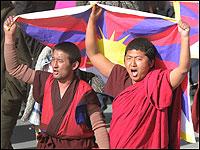Transcript
BROOKE GLADSTONE:
And I'm Brooke Gladstone. According to the Chinese government, more than 20 people have died this month during protests in Tibet. According to Tibetan exiles, nearly 140 lost their lives. It's been hard for Western reporters to get a firm grip on the numbers or even the players.
Jeremy Goldkorn is the founder and director of Danwei.org, a media analysis site based in Beijing. He says that both East and West have fallen into an information gap.
JEREMY GOLDKORN:
The two views are pretty extreme. On the one hand, you have the hippy, smiling, peaceful Buddhist monks that tends to be the perception in the West. And in China, for most Han Chinese people, which is most of the country, they tend to think of Tibet as a brutal, feudal country that was liberated by the Communist Party from its feudal shackles and then has had a great deal of investment.
I don't mean here to, you know, defend anything the Chinese government has done into that, particularly, but I do think what is missing from the reportage is nuance. I think the situation is not as clear cut as it can seem.
For various reasons, you know, mostly through the Chinese government's own issues.
It's very difficult to get information from Tibet. There are not a lot of journalists there. There are not a lot of research organizations. NGOs have a tough time to operate. Because of this, it's very difficult to get information about Tibet that does not come from either the propaganda machine in Beijing or the propaganda machine coming out of the Tibetan Government in Exile in Dharamsala.
BROOKE GLADSTONE:
Whether the West is entirely right or partly wrong, the pictures of protesting monks are starting to have Olympic-sized ramifications. This was not anticipated by the insular Chinese when it won the Games, and it comes as a shock even now, complicated by China's close financial ties with Sudan, which human rights activists say abets the genocide in Darfur.
